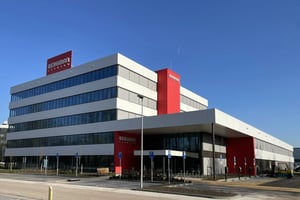Business is a matter of managing risks in order to take full advantage of opportunities. This is especially true in distant foreign markets, where a company lacks a detailed understanding of the culture or the market. Yet distant foreign markets offer attractive opportunities for companies with a distinctive product. These markets are often both less mature and less saturated. In most cases the local competition is less developed or lagging behind in terms of quality or technology. In short, for those who know how to manage the risks, internationalisation can bear fruit. Dieseko Group, which engineers and produces vibratory hammers, cranes and power packs for the foundation industry, is one such company rapidly expanding its international operations.
Based in Sliedrecht in the Netherlands, the group is fast developing a leading position in its global niche market. After a supervisory board meeting, Dieseko’s supervisory board members, Paul van Es, Wim van Aalst and Rutger Ruigrok, share their views on the opportunities and risks of international expansion. They refer to Dieseko as an example, but discuss the subject in a broad sense based on their background and experience. The key question is, what insights have they gained as a supervisory board member, majority shareholder or investment director? And what do they do about it?
What are the risks?
Paul van Es can easily point to the risks of internationalisation in the current economic climate. “Things are not going well, especially in emerging markets. Economies continue to falter and further slowing of the Chinese economy will have a major impact. At the same time trade with Russia is affected by a boycott. This alone has caused us to lose a considerable number of deals. The outlook is also bleak in the oil and gas sector, where more than 1,000 billion in investments worldwide have been put on ice. These are all unforeseeable developments and circumstances, but companies have to be able to cope with them.”
Wim van Aalst: “Thorough preparation helps mitigate risks. Explore the market, bring in advisors if necessary, and focus primarily on the insights you gain from this, more so than on the costs. Having said this, preparation has its limits. Thoroughness is achieved at the expense of speed: detailed market research can take months. If an opportunity arises you have to be able to act fast.
All of the men at the table agree that thorough preparation can substantially reduce the catalogue of risks associated with internationalisation. But are there still risks that cause them to lose sleep at night? The response is immediate and unanimous. Yes, the prospect of a local business partner or dealer with whom you are developing a new activity in a foreign market making the wrong move.”
Human interaction
Paul van Es: “Above all, you are dealing with people and human interaction. Is your local partner reliable and capable? And do you understand each other? You can’t tell this from a few meetings and a credit status report. You have to work it out as you go along, step by step. You start cautiously, operate on a small scale and only invest what you can afford to lose. Keep a close eye on the way things are developing and make sure you always have the option of pulling out.”
Rutger Ruigrok: “Conversely, once you have found the right partner, you can step up a gear. Dieseko owes its success in Singapore to the fact that we are working with an excellent local partner. Then business can take off and the company can invest more in the partnership. Dieseko now has its own office in Singapore, which is serving as an important growth engine for the region as a whole.”
Wim van Aalst: “The success of such a partnership largely depends on mutual understanding, and that can be very difficult. With all of the linguistic and cultural differences, how can you be certain that you really understand each other? You have different customs and etiquette and the way you perceive things also differs. This can lead you to interpret the same facts and what you say to each other very differently. I am not talking about ill will. Even with the best of intentions you may still be talking at cross purposes. You leave the meeting feeling good about things and a week later your foreign partner does something that takes you completely by surprise.”
Rutger Ruigrok: “It is necessary to invest considerable time and effort in maintaining the relationship. Even when partners are well acquainted and the partnership has matured, this requires more than two visits a year. And contact shouldn’t be confined to management level. At Dieseko a technical manager travels to Singapore for a monthly management meeting to ensure that the company is operationally aligned.”
Why should a company embark on ventures in foreign markets when it involves so many risks and requires so much time and attention?
Paul van Es thinks the answer is self-evident: “It would be poor entrepreneurship not to exploit opportunities for your product or service in other markets. Internationalisation is not an end in itself. It’s not a matter of simply generating more revenues and establishing a global presence. It’s about growing profitable revenues to make the company stronger.”
Wim van Aalst: “International expansion involves risks, yet at the same time it also spreads the risks. Companies that derive the majority of their revenues from Russia will be struggling at the moment. Activities in Western Europe, Brazil or the Far East help soften the impact of the Russia boycott. Expansion in emerging markets gives a company new growth prospects outside the saturated European markets.”
Paul van Es: “Spread is strategically important. And by that I mean not only geographical spread across markets, but also the spread of products and business concepts you offer in these markets. Dieseko has added cranes and power packs to the range of equipment it offers, which can be purchased or leased. If you supply a wide array of products to customers in different sectors in several geographical markets, you have a company that can withstand economic headwinds.”
To what extent can international expansion be planned by applying the principles of entrepreneurship and spread?
Only to a limited extent, says Rutger Ruigrok. “The strategic plan provides direction. The company has some idea of the markets in which it intends to operate, but it’s impossible to predict the exact steps, the order in which they need to be taken and the speed at which this can happen. That always depends on the circumstances and the opportunities that arise.”
Wim van Aalst: “That’s one of the most appealing things about running a business, you have to be able to adapt to circumstances. It’s all part of the adventure! Things rarely work out exactly the way you planned. You hear things, you do market research, you travel to a region... You don’t have any control over the opportunities that arise or the places where that happens. Sometimes you can’t find the right partner. Or the partner you found fails to measure up, so you have to take a step back and start again. Of course, there’s also every chance that you will find the perfect acquisition candidate. It’s all part of the game.”
Paul van Es: “You need to ensure that you are moving in the right direction strategically and achieving the required spread. Now we have the internet there is no need to develop a presence in every country. Professionals who can read product specifications are quite happy to order vibratory hammers online if necessary. And if it’s urgent, the order can be put on a 747. You don’t need a local presence for that.”
During the process of internationalisation supervisory board membors, shareholders and investment managers are not the ones at the helm. They approve the expansion strategy, after that they have to allow the management team to execute it. What can they add? How can they help steer the process in the right direction? And how difficult is it to maintain the appropriate distance, especially for a supervisory board member who formerly served as chief executive and has the relevant experience?
Paul van Es smiles, “Yes, I do worry sometimes. But I know perfectly well that the management team must be free to act as it sees fit. I am also well aware that our input as supervisory board members is effective precisely because we maintain a certain distance.”
Wim van Aalst: “The secret is to ensure a good flow of information, so you can participate in the discussion on a one-to-one basis. In the case of a company such as Dieseko, the fact that an investment director scrutinises a monthly financial report and monitors the results helps enormously. If anything falls out of line over there, we see the signs immediately. We also make a point of maintaining regular informal contact between meetings. If we have questions, we ask for additional information.”
Rutger Ruigrok: “A good relationship with the management is essential in creating an open dialogue. You need to be able to communicate openly if an opportunity arises and you have to act fast. And it helps enormously if the supervisory board has a feel for the business and the shareholders are involved in the discussion. Then you can efficiently weigh up the opportunities and risks, assess the required investments and strengthen the company’s capital position if necessary.”
Strategy sessions
Paul van Es: “Time invested in building in a close working relationship between the management and supervisory boards pays off. At Dieseko in addition to our regular meetings, we also have an annual session on strategy. Without an imperative agenda, we can discuss fundamental issues such as how fast we want to move, what we want to achieve, what risks we are prepared to take and what opportunities we see. If you take the time to do this, you then have a shared context on which to base decisions.”
An ambitious management will sometimes bite off more than it can chew, or become very attached to a particular deal. How do supervisory board members prevent this from happening?
Wim van Aalst: “Above all, you have to ensure that the management is capable of achieving the strategic objectives. If you decide to pursue an ambitious internationalisation agenda, you have to strengthen the management team so it can execute the strategy. Then it’s a matter of identifying opportunities and risks, weighing them up and ensuring that you keep things manageable.”
Rutger Ruigrok: “In the case of a growth strategy, it’s all the more important that the company is conservatively financed. If you have adequate capital buffers, you can withstand opposing forces and take a step back. Then you can speed up again when new opportunities arise.”
Who's who?
Paul van Es was there at the inception of Dieseko 20 years. He is director and shareholder of a group of six companies that supply services and products to the global construction and offshore industry and is familiar with the perils of cross-border ambitions in each of these niche markets.
Wim van Aalst is founder and director of NileDutch, a Rotterdam shipping company that operates cargo liner services between Europe, South Africa, South America and Asia and West African ports. He became acquainted with the opportunities and risks of foreign ventures while building the shipping firm and has a large personal network in Africa.
Rutger Ruigrok is an investment director involved in the internationalisation of the portfolio companies he manages for majority shareholder NPM Capital, including Dieseko and NileDutch. He is familiar with the issues to be considered in managing risks and financing this process in widely diverse sectors.













